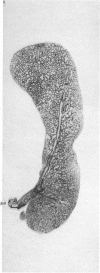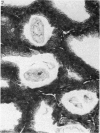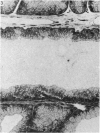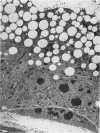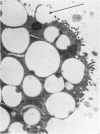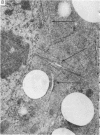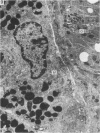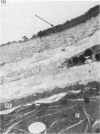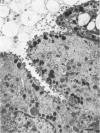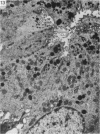Abstract
The Harderian gland, its secretory duct and porphyrin content were examined in the mongolian gerbil (Meriones unguiculatus). The gland consisted of tubules lined by a single layer of epithelial cells and a myoepithelial network. The tubule cells were often binucleate and possessed lipid vacuoles in the apical half of the cell, a corona of granular endoplasmic reticulum surrounding the nucleus, and cytoplasmic 'slashes'. The latter are probably derived from dense membranous couplets and may be precursors of the lipid vacuoles. Holocrine and merocrine secretion was observed. Interstitial cells included plasma cells, mast cells and (predominantly) melanocytes which render the gland black. The gland was surrounded by a collagen capsule and an outer layer of highly attenuated (possibly endothelioid) cells. Within the gland, the secretory duct was lined by a single layer of normal tubule cells. Outside the gland, the duct enlarged to form an ampulla, from which clefts led off to deep crypts. The ampulla and clefts were lined by cells with small dense apical granules and stubby microvilli; some possessed lipid vacuoles. The crypts were lined by serous cells with active Golgi regions. At the duct opening, ampullary cells became squamous and goblet cells occurred. Geometric crystalloid deposits (with a layered structure of 7.6 nm periodicity) occurred at cleft-crypt junctions. Islets of extra-glandular ductal tissue were occasionally found within the gland. Porphyrins were detectable both by chemical assay and fluorescence microscopy. There was a trend for female glands to have a higher content than males. Solid intraluminal accretions of porphyrin and/or lipid were present.
Full text
PDF

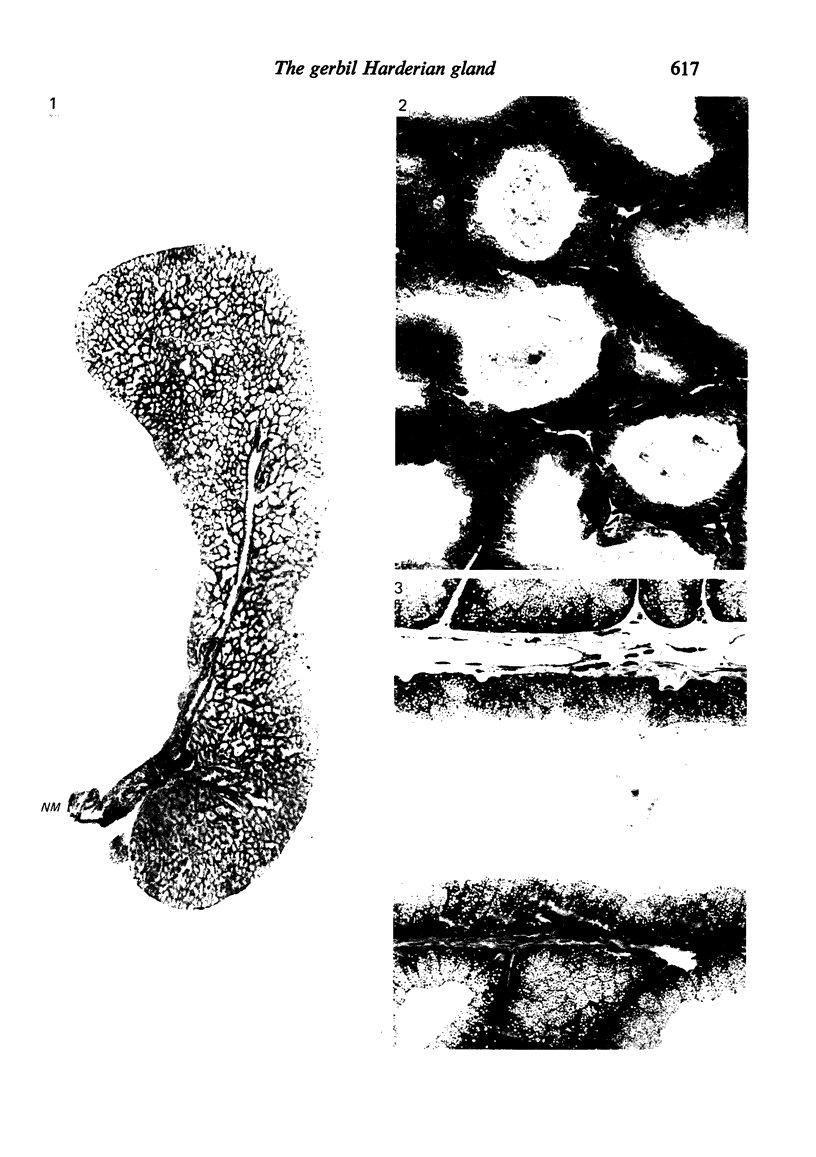

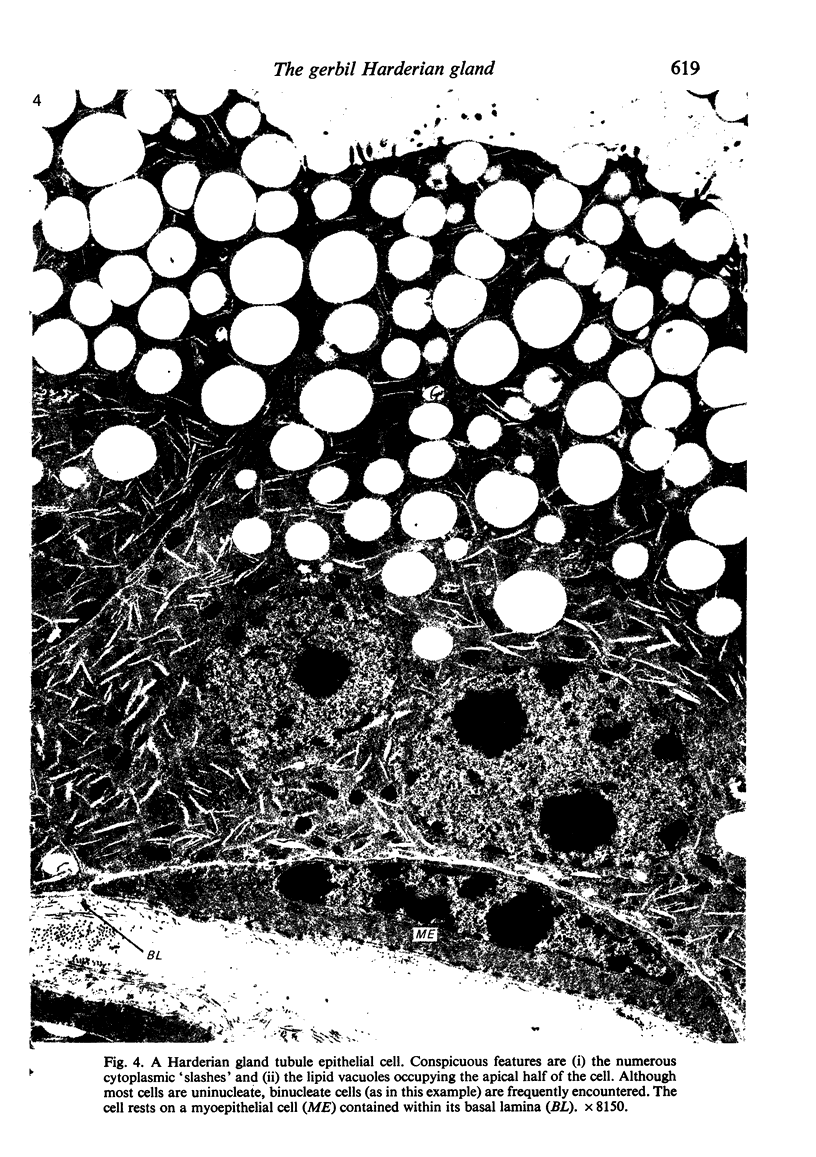
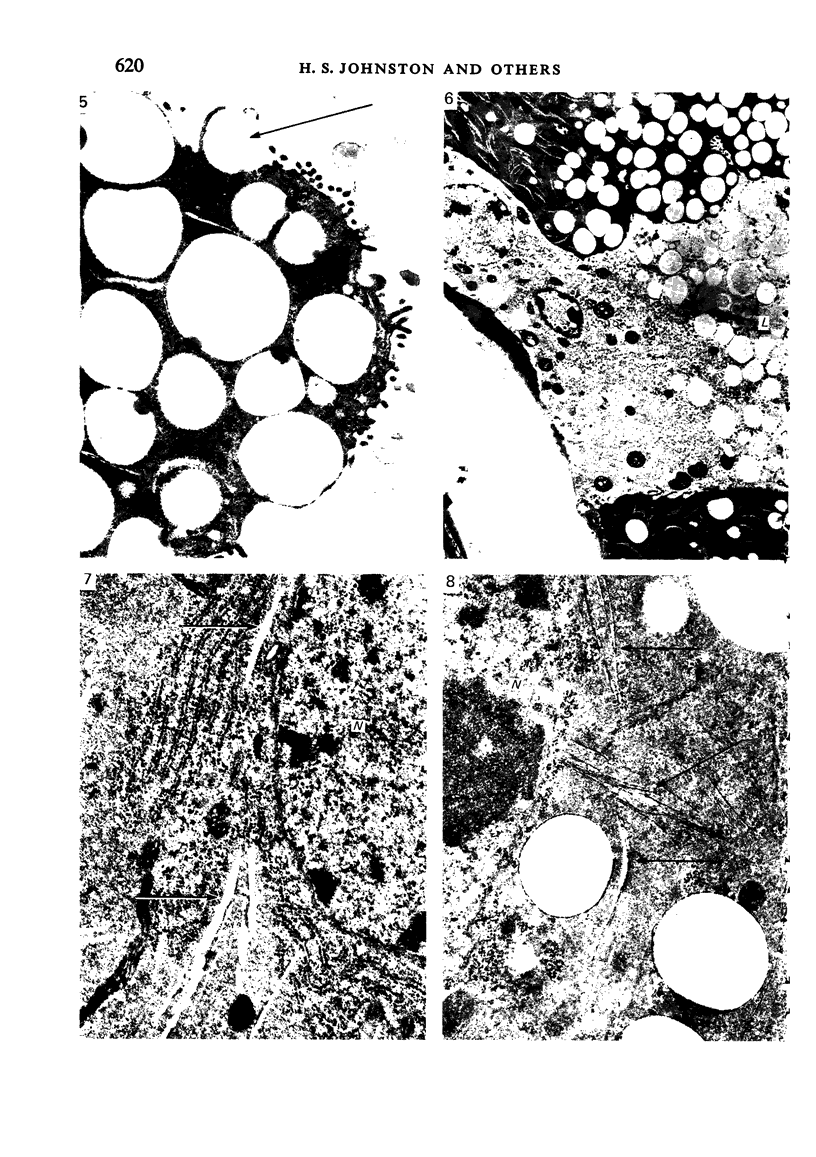
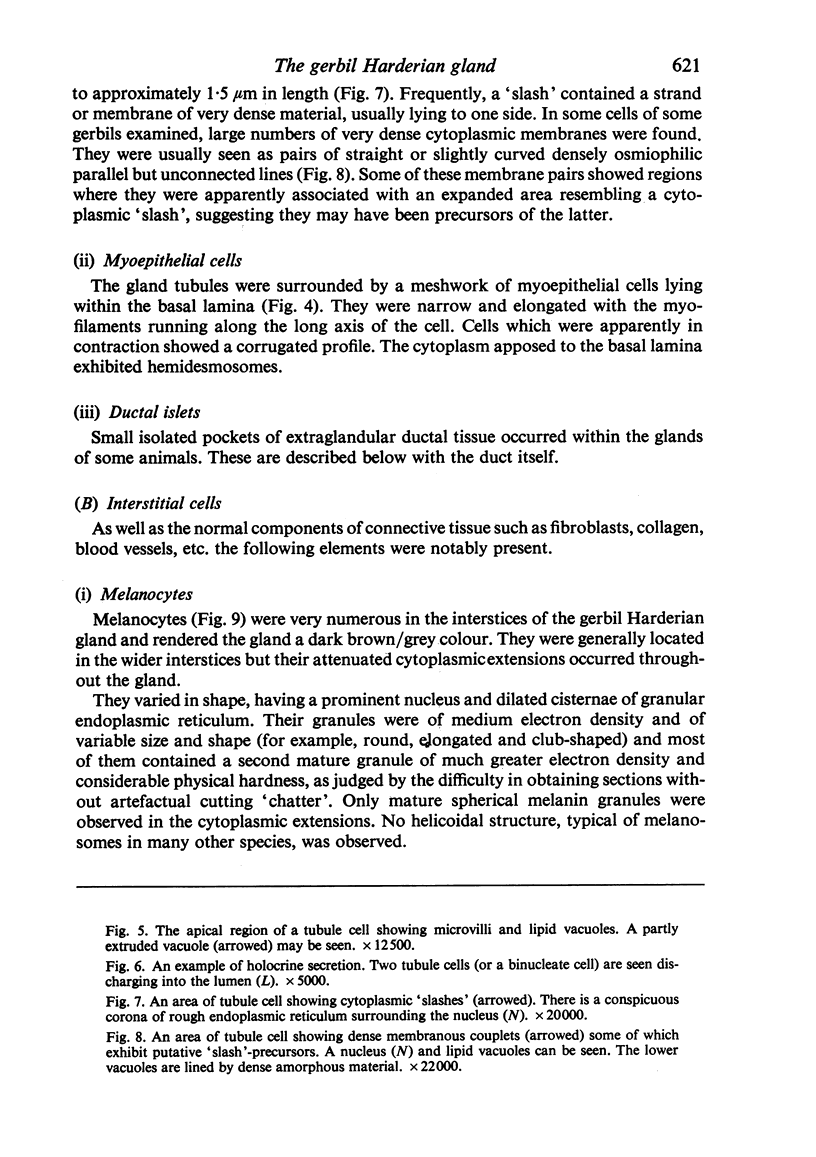
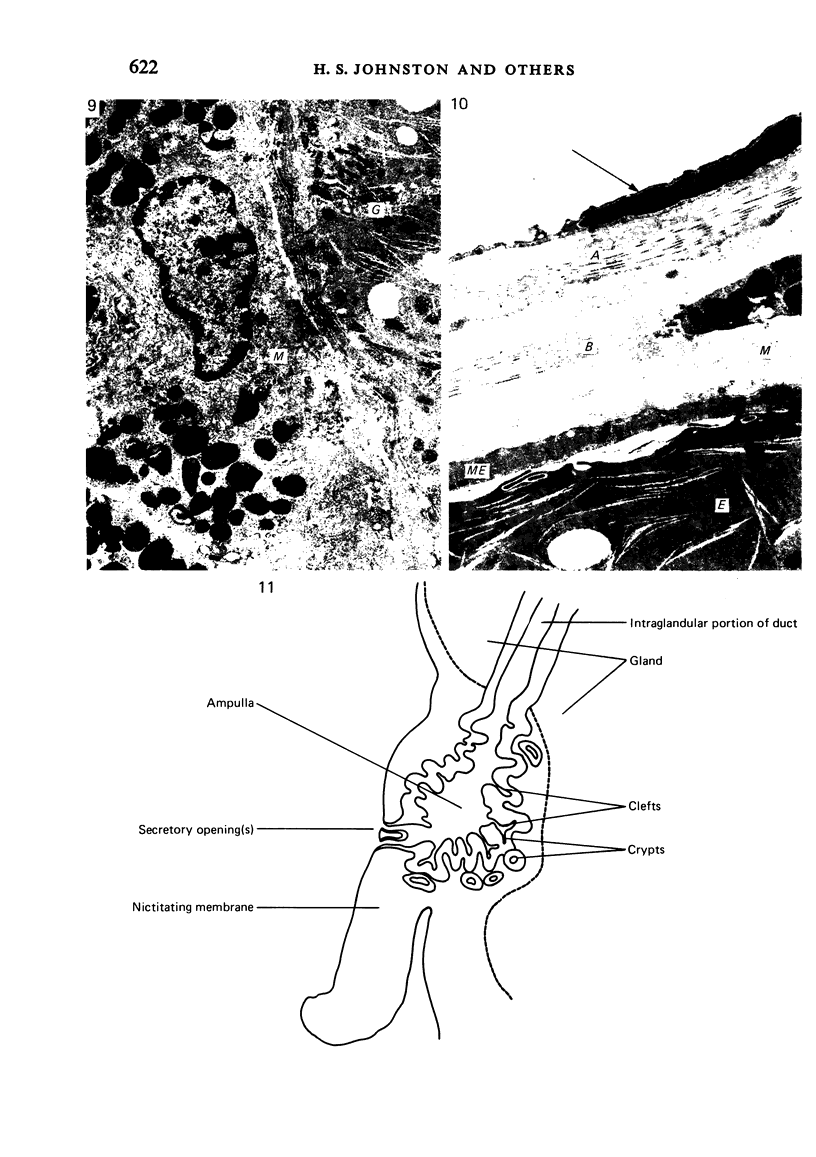
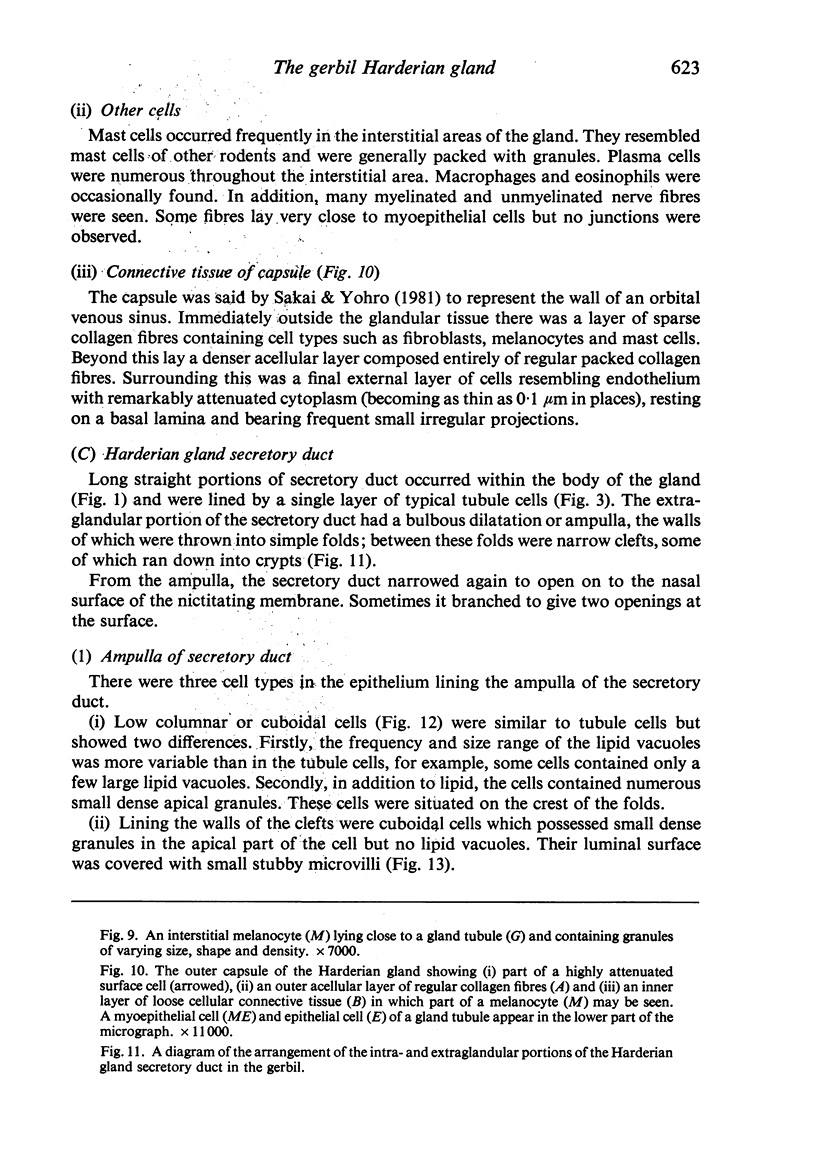

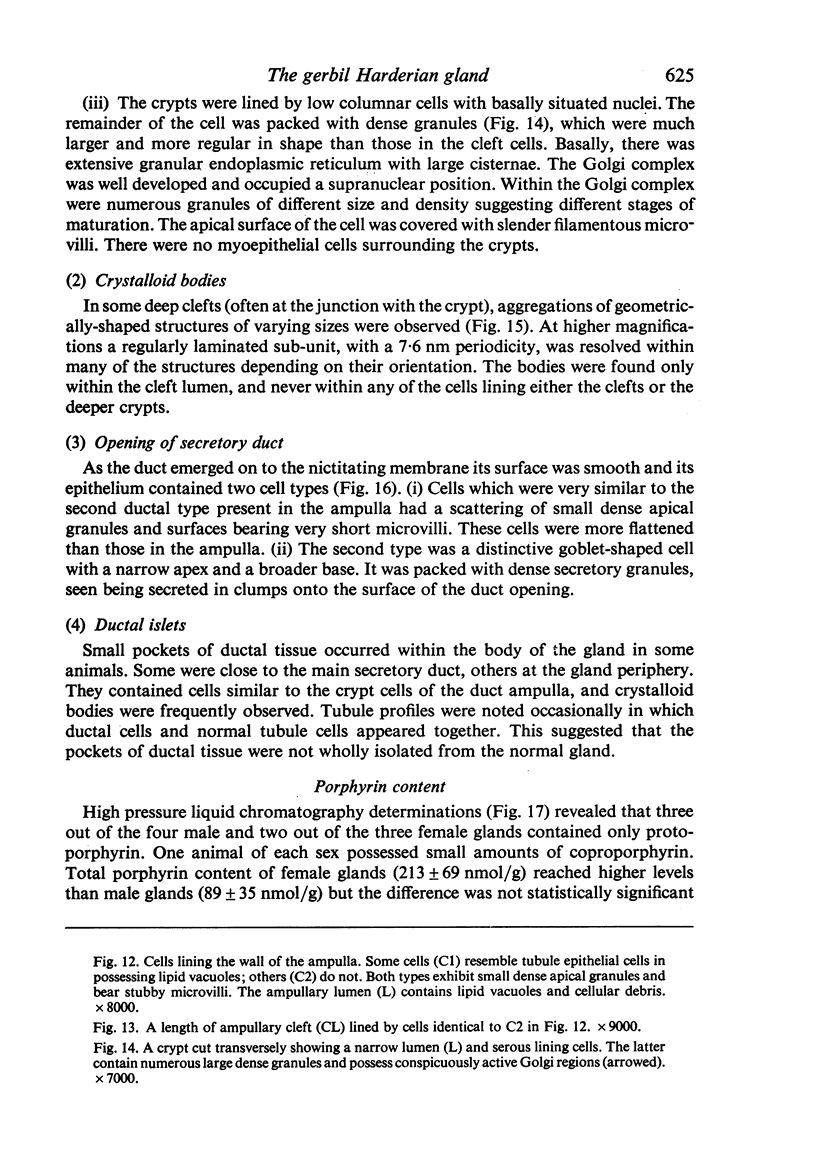
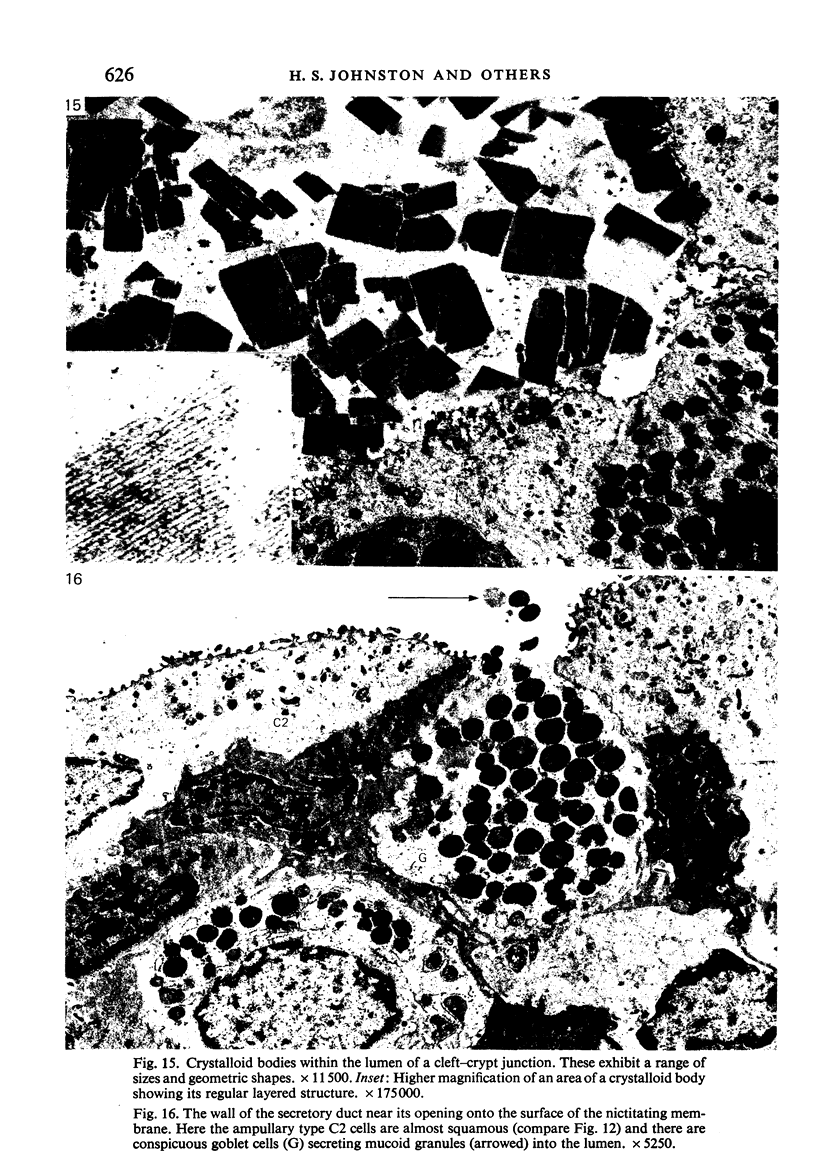

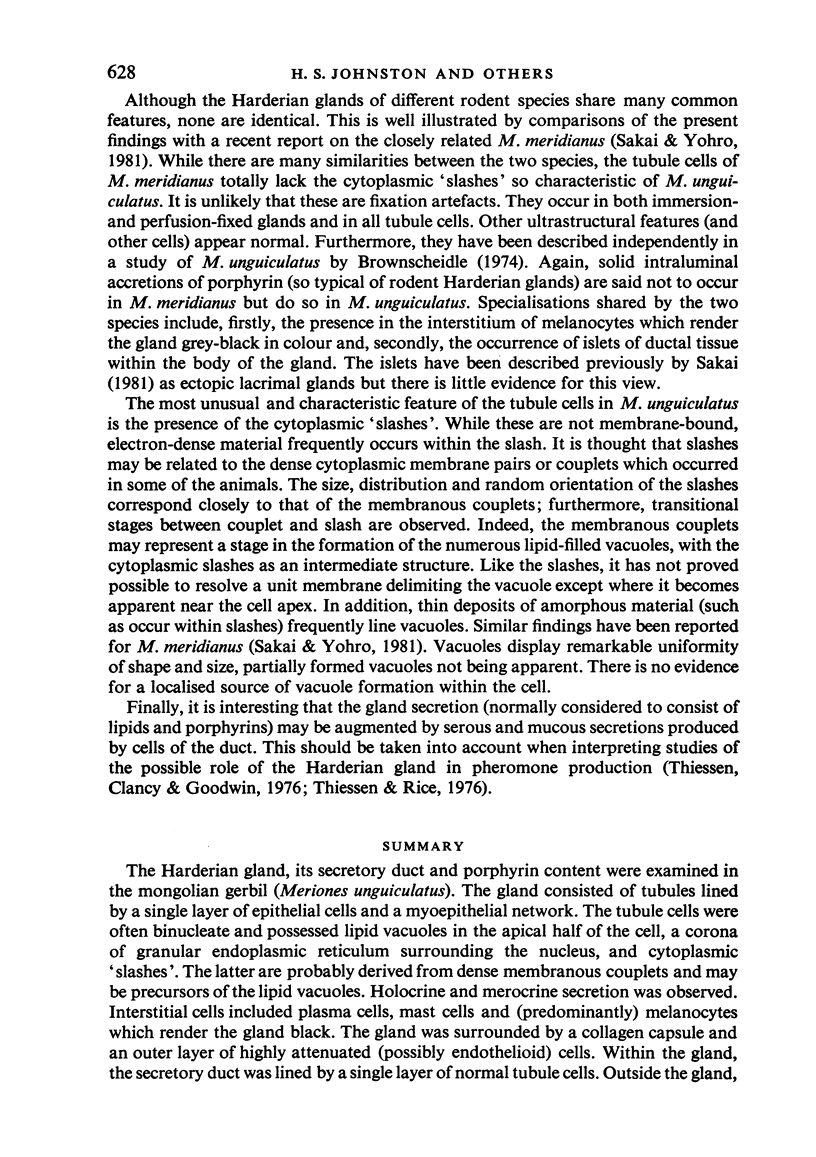
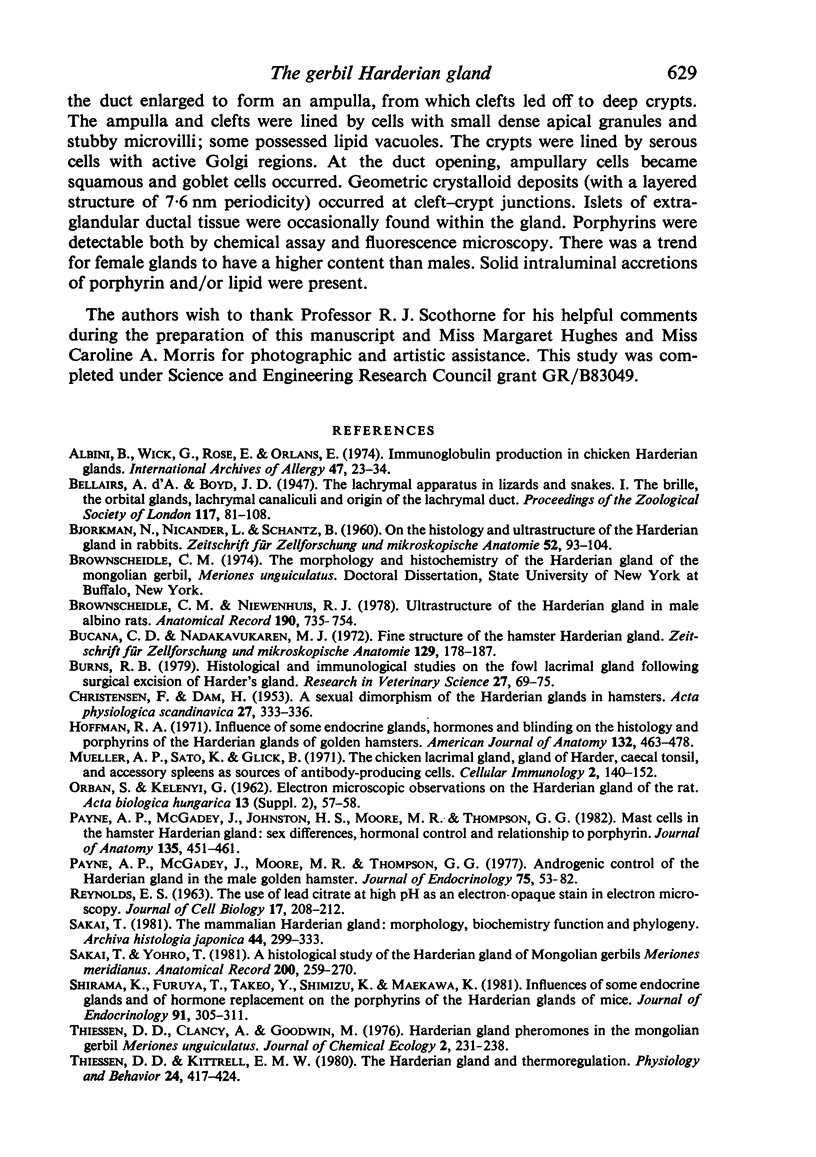
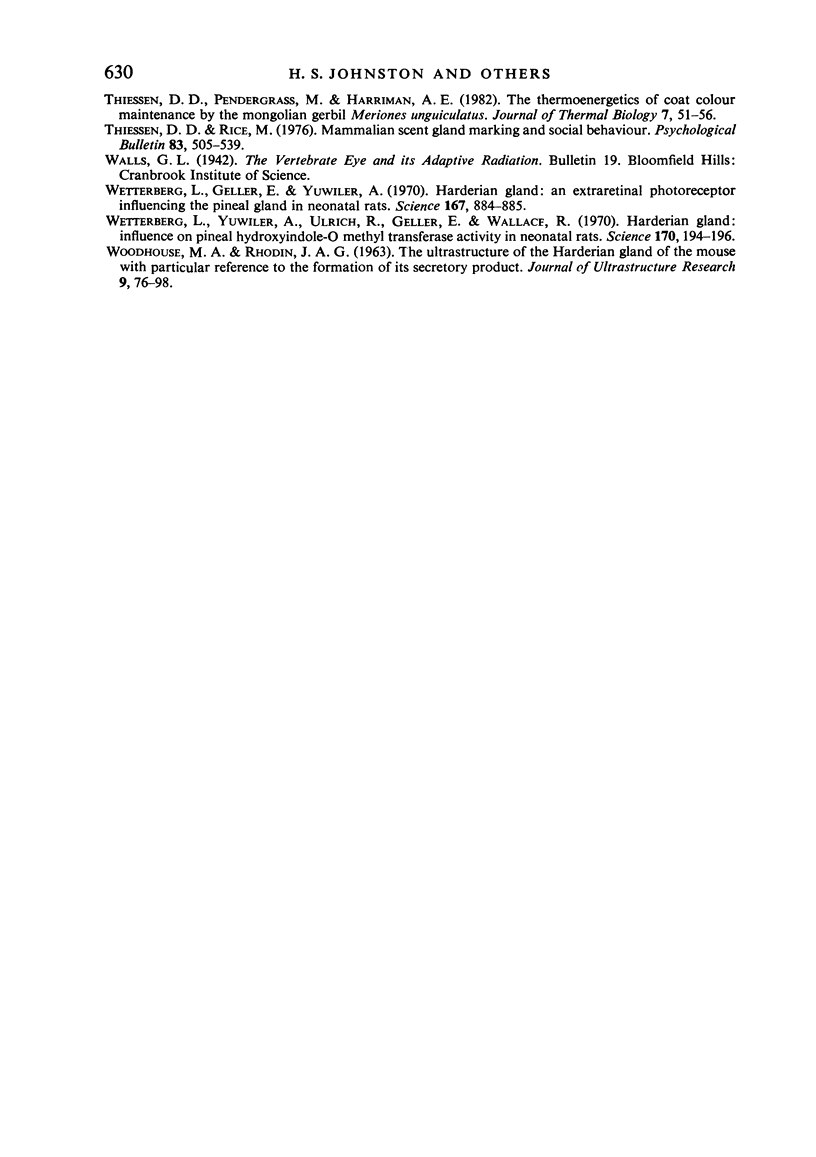
Images in this article
Selected References
These references are in PubMed. This may not be the complete list of references from this article.
- Albini B., Wick G., Rose E., Orlans E. Immunoglobulin production in chicken Harderian glands. Int Arch Allergy Appl Immunol. 1974;47(1):23–34. doi: 10.1159/000231198. [DOI] [PubMed] [Google Scholar]
- BJOERKMAN N., NICANDER L., SCHANTZ B. On the histology and ultrastructure of the Harderian gland in rabbits. Z Zellforsch Mikrosk Anat. 1960;52:93–104. doi: 10.1007/BF00344641. [DOI] [PubMed] [Google Scholar]
- Brownscheidle C. M., Niewenhuis R. J. Ultrastructure of the harderian gland in male albino rats. Anat Rec. 1978 Mar;190(3):735–753. doi: 10.1002/ar.1091900309. [DOI] [PubMed] [Google Scholar]
- Bucana C. D., Nadakavukaren M. J. Fine structure of the hamster Harderian gland. Z Zellforsch Mikrosk Anat. 1972;129(2):178–187. doi: 10.1007/BF00306934. [DOI] [PubMed] [Google Scholar]
- Burns R. B. Histological and immunological studies on the fowl lacrimal gland following surgical excision of Harder's gland. Res Vet Sci. 1979 Jul;27(1):69–75. [PubMed] [Google Scholar]
- CHRISTENSEN F., DAM H. A sexual dimorphism of the harderian glands in hamsters. Acta Physiol Scand. 1953 Feb 28;27(4):332–336. doi: 10.1111/j.1748-1716.1953.tb00935.x. [DOI] [PubMed] [Google Scholar]
- Hoffman R. A. Influence of some endocrine glands, hormones and blinding on the histology and porphyrins of the Harderian glands of golden hamsters. Am J Anat. 1971 Dec;132(4):463–478. doi: 10.1002/aja.1001320405. [DOI] [PubMed] [Google Scholar]
- Mueller A. P., Sato K., Glick B. The chicken lacrimal gland, gland of Harder, caecal tonsil, and accessory spleens as sources of antibody-producing cells. Cell Immunol. 1971 Apr;2(2):140–152. doi: 10.1016/0008-8749(71)90033-5. [DOI] [PubMed] [Google Scholar]
- Payne A. P., McGadey J., Johnston H. S., Moore M. R., Thompson G. G. Mast cells in the hamster Harderian gland: sex differences, hormonal control and relationship to porphyrin. J Anat. 1982 Oct;135(Pt 3):451–461. [PMC free article] [PubMed] [Google Scholar]
- Payne A. P., McGadey J., Moore M. R., Thompson G. Androgenic control of the harderian gland in the male golden hamster. J Endocrinol. 1977 Oct;75(1):73–82. doi: 10.1677/joe.0.0750073. [DOI] [PubMed] [Google Scholar]
- REYNOLDS E. S. The use of lead citrate at high pH as an electron-opaque stain in electron microscopy. J Cell Biol. 1963 Apr;17:208–212. doi: 10.1083/jcb.17.1.208. [DOI] [PMC free article] [PubMed] [Google Scholar]
- Sakai T. The mammalian Harderian gland: morphology, biochemistry, function and phylogeny. Arch Histol Jpn. 1981 Sep;44(4):299–333. doi: 10.1679/aohc1950.44.299. [DOI] [PubMed] [Google Scholar]
- Sakai T., Yohro T. A histological study of the Harderian gland of Mongolian gerbils, Meriones meridianus. Anat Rec. 1981 Jul;200(3):259–270. doi: 10.1002/ar.1092000304. [DOI] [PubMed] [Google Scholar]
- Shirama K., Furuya T., Takeo Y., Shimizu K., Maekawa K. Influences of some endocrine glands and of hormone replacement on the porphyrins of the Harderian glands of mice. J Endocrinol. 1981 Nov;91(2):305–311. doi: 10.1677/joe.0.0910305. [DOI] [PubMed] [Google Scholar]
- Thiessen D. D., Kittrell E. M. The Harderian gland and thermoregulation in the gerbil (Meriones unguiculatus). Physiol Behav. 1980 Mar;24(3):417–424. doi: 10.1016/0031-9384(80)90229-2. [DOI] [PubMed] [Google Scholar]
- Thiessen D., Rice M. Mammalian scent gland marking and social behavior. Psychol Bull. 1976 Jul;83(4):505–539. [PubMed] [Google Scholar]
- WOODHOUSE M. A., RHODIN J. A. THE ULTRASTRUCTURE OF THE HARDERIAN GLAND OF THE MOUSE WITH PARTICULAR REFERENCE TO THE FORMATION OF ITS SECRETORY PRODUCT. J Ultrastruct Res. 1963 Aug;49:76–98. doi: 10.1016/s0022-5320(63)80037-4. [DOI] [PubMed] [Google Scholar]
- Wetterberg L., Geller E., Yuwiler A. Harderian gland: an extraretinal photoreceptor influencing the pineal gland in neonatal rats? Science. 1970 Feb 6;167(3919):884–885. doi: 10.1126/science.167.3919.884. [DOI] [PubMed] [Google Scholar]
- Wetterberg L., Yuwiler A., Ulrich R., Geller E., Wallace R. Harderian gland: influence on pineal hydroxyindole-O-methyltransferase activity in neonatal rats. Science. 1970 Oct 9;170(3954):194–196. doi: 10.1126/science.170.3954.194. [DOI] [PubMed] [Google Scholar]



